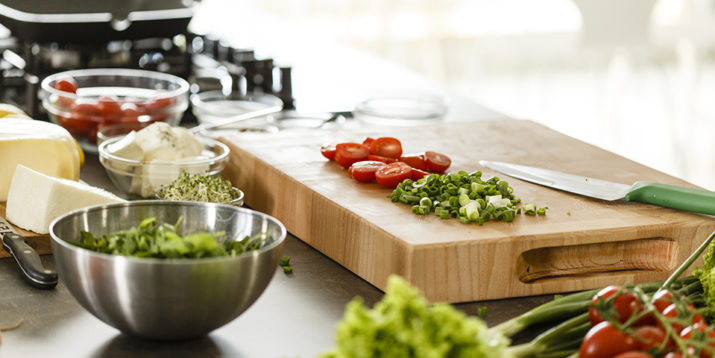5 Tips to Keep Your Wood Cutting Board Clean

Wood cutting boards are crucial tools for food prep and cooking, whether you’re chopping up some DIY carrot and celery sticks to snack on with hummus, making skinny beef stroganoff for dinner, or getting fancy with some fresh pineapple.
Many people prefer wood cutting boards because they won’t dull your knives as quickly as — or get nicked as easily as — plastic cutting boards.
However, there are some critical tips for wood cutting board care. For example, wood cutting boards and dishwashers don’t mix.
Instead, there’s special wood cutting board care you should follow.
“Don’t put wooden cutting boards in the dishwasher!” warns Leah Barron, a New York City-based registered dietitian. “The high heat and extended time in water can lead to cracks in the wood that can harbor bacteria.”
To keep your chopping surface in prime chopping condition, here’s how to take care of a wooden cutting board.

1. Wash
First, wipe or rinse off any crumbs or leftover food bits and then wash your board in warm soapy water, recommends Barron.
“Wash both sides even if you didn’t use the other side because you never know what contaminants are on the countertop,” she adds.
Washing both sides also prevents uneven warping and a wobbly board.
“Pay extra attention to any areas on the board with knife cuts or cracks and give those spots an extra scrub,” she says.
Wood cutting boards are less vulnerable to scratches than plastic cutting boards.
According to the USDA, bamboo wood cutting boards are harder and more resistant to bacteria than other wood types.
2. Disinfect
“If you’re using the board to cut raw meat or poultry, this is especially important,” says Barron.
She recommends one of the following cleaning mixtures:
- One-part white vinegar to four-parts water.
- A tablespoon of bleach in a gallon of water.
“Let the board soak for around five minutes, and then rinse well and dry thoroughly,” Barron says.
The UDSA also recommends a diluted bleach-water solution, but some studies suggest an ammonia-based cleaner is better for wood boards.
As an extra precaution, the USDA recommends having a dedicated board for meat and seafood, and another board for fruits, veggies, nuts, cheeses, and breads.
“Don’t leave the board to soak in water or disinfecting solution for more than a few minutes because the wood will start to warp,” says Barron.
3. Dry
After washing, thoroughly dry your wood cutting board with a clean towel and allow it to air dry standing upright in a dish rack.
Drying is the most vital step for preventing your board from warping or cracking.

4. Condition
“To help maintain the quality of your wooden cutting boards, oil the board at least once a month with a cutting board oil or food-grade mineral oil,” recommends Barron. “This helps to avoid drying, cracking, and warping.”
You can easily purchase food-grade mineral oil, such as Thirteen Chefs Food-Grade Mineral Oil or Clark’s Cutting Board Oil enriched with orange and lemon extracts, online.
When you oil your board, make sure it’s completely dry — ideally after sitting overnight or several hours.
“Don’t use cooking oils such as olive oil or avocado oil on the boards because the fats in these oils will go rancid and cause the board to smell,” says Barron.
Spread a thin layer of oil on the board and allow it to soak for a few hours. Then wipe the board with a dry cloth or paper towel.
5. Know When to Hold ‘Em, Know When to Fold ‘Em
These tips can extend your wood cutting board’s lifespan, but you need to replace all cutting boards eventually.
“Don’t continue to use wooden cutting boards that have deep knife cuts that are difficult to clean thoroughly,” says Barron.
The USDA also recommends discarding both plastic and wood cutting boards with deep grooves.
